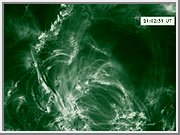|
COMETS EARTH JUPITER KUIPER BELT MARS MERCURY METEORITES NEPTUNE OORT CLOUD PLUTO SATURN SOLAR SYSTEM SPACE SUN URANUS VENUS ORDER PRINTS
PHOTO CATEGORIES SCIENCEVIEWS AMERICAN INDIAN AMPHIBIANS BIRDS BUGS FINE ART FOSSILS THE ISLANDS HISTORICAL PHOTOS MAMMALS OTHER PARKS PLANTS RELIGIOUS REPTILES SCIENCEVIEWS PRINTS
|
Related Document
Download Options
Solar moss consists of hot gas at about two million degrees Fahrenheit which emits extreme ultraviolet light observed by the TRACE instrument. It occurs in large patches, about 6,000 - 12,000 miles in extent, and appears between 1,000 - 1,500 miles above the Sun's visible surface, sometimes reaching more than 3,000 miles high. It looks "spongy" because the patches are composed of small bright elements interlaced with dark voids in the TRACE images. These voids are caused by jets of cooler gas from the Sun's lower atmosphere, the chromosphere, which is at about 10,000 degrees Fahrenheit. The solar moss appears only below high pressure coronal loops in active regions, typically persisting for tens of hours, but has been seen to form rapidly and spread in association with loops that arise after a solar explosion, called a flare. |
